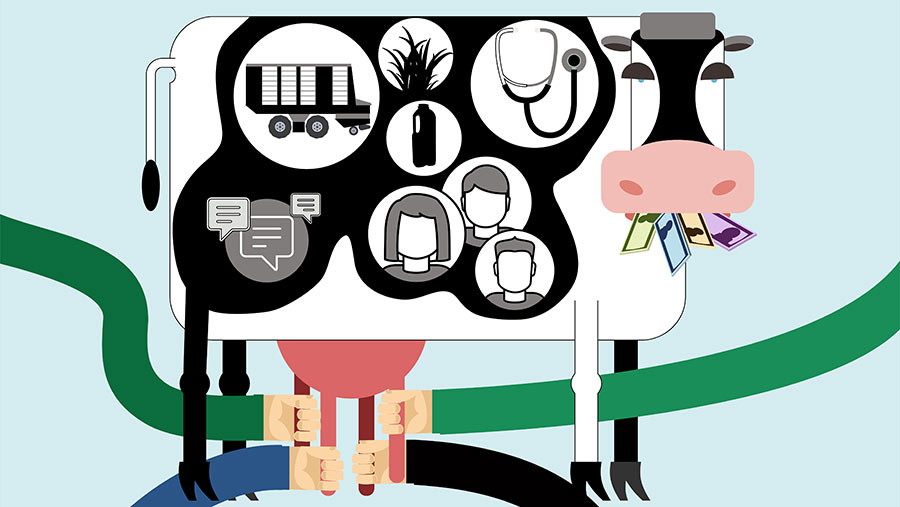7 ways to lift profits on your dairy farm
 © Ingram Image
© Ingram Image The new year is always a good time to look to the future and business development.
Identifying where to spend your limited time and resources is crucial: it can seem like a never-ending list.
Kite Consulting’s Joss Fawcett identifies seven key areas that he thinks will be key to profitability on dairy farms over the next few years.
See also: How Nuffield scholarship help farm ownership dream
1. Get a good handle on your costs
Whether a business is assessed on total profit, profit per litre, or breakeven milk price, it always surprises me how many dairy farmers do not have a good handle on costs.
It is imperative that businesses create the time to challenge costs by comparing them with peers, and with those from previous years.
With MTD (Making Tax Digital) now coming into force, it is a great time to ensure you are using the correct software to give you the management accounts to do this.
2. Understand your milk contract
We see a huge range in milk prices being achieved by dairy farmers on the same contracts.
Understanding your milk contract and knowing exactly what it is you are being paid for is the first step to making the most from it.
Many producers are being paid for kgs of milk solids but still talk in terms of litres. Make kgs of milk solids a cow a day your key KPI rather than litres a cow, if this is what you are paid for.
Personally, I am a big fan of examining margin produced over all feeds.
On constituent-based contracts it is easy to think that C16 fat is very expensive and will increase feed cost per litre, however, if it gives a return over and above the cost then does it really matter if the feed cost per litre has increased?
Look at how your system can most efficiently produce what you are being paid for.
Remember you can increase milk solids sold both by increasing constituent percentage per litre and by producing more litres while maintaining existing constituents.
3. Maximise profitability per cow space
Each cow place has a cost associated with it (housing, labour, feed etc). Aim to make every cow place as profitable as possible by increasing output.
Small things such as pushing feed up more often, improving lighting or cleaning out water troughs more regularly don’t cost much but can make a difference to yields, constituents and fertility.
4. Embrace new technologies
Genomics is just one example of the many new technologies that are being made widely available to the dairy industry and can help make huge differences to future profitability.
It allows you to increase beef calf sales though a reduction in the proportion of B&W bulls produced and helps you to breed from the right dam.
The second wave of heat detection tools, such as SenseTime, Cow Manager and the Nedap Smarttag can help save time, reduce labour needs and help save costs.
They ultimately allow you to reduce the cost of generating pregnancies by not only indicating the best time to serve cows, but also highlighting the optimum time to use sexed semen, improving pregnancy rates.
They will also reduce the reliance on vet intervention to generate heats and can assist in the early detection of health problems, allowing you to intervene quicker than traditionally possible.
Look out for available grant schemes this year when it comes to investing in these technologies.
5. Develop strong people skills
Many resilient businesses have managers/owners that have strong people skills.
The ability or inability to retain, manage and motivate staff effectively can drive a business forward or hold it back.
Having a good team is a great way to ensure you free up enough time for you to manage the business. Having everybody pulling in the same direction will only make your life easier.
6. Plan for succession
Succession is all too often the elephant in the room, stopping a business moving forward.
Making sure this issue is addressed means adequate financial planning can take place and the business can have the whole family pulling together.
I believe it is best to bring in a third party who is completely independent from the farm business.
7. Build social capital
Building social capital is important for the long-term development of a business.
Without the goodwill of consumers on the larger scale, and the local community and neighbours on a smaller scale, the long-term viability of the business can be in doubt.
We are already seeing examples of business expansion plans being halted by neighbours raising concerns with local authorities about planning applications.
Poor tractor driving through built-up areas and unpleasant odours can also cause neighbours to complain.
By ensuring you and your staff drive farm machinery in a courteous manner in your village, taking part in Open Farm Sunday and making sure people know the steps you are taking to protect and enhance the environment, you can build goodwill (social capital) with your immediate neighbours and local community.
